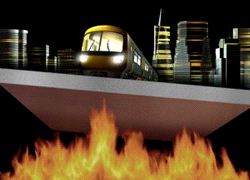Consumables
One more step towards fire safety

Monday 22. September 2008 - BASF foam passes tests of the EU fire classification standards for buildings and trains
BASFs thermoset foam, Basotect UF, already now attains the highest possible rating for organic insulating materials according to the new, more stringent EU fire-protection standards for buildings and trains. At present, these two EU directives still exist alongside the national regulations, but they will completely replace them in the coming years. By meeting the new EU standards, Basotect UF, which is employed primarily for sound absorption and thermal insulation, gives engineers and processors in all European countries the planning reliability needed to design the insulation of buildings and railroad vehicles. In Germany, Basotect UF is rated as a construction material of “low flammability” (DIN 4102-1 B1).
B rating in the more stringent EU fire classification standard for construction materials
According to EU standard EN 13501-1, whose fire tests will be mandatory in the future for all building construction materials, Basotect UF attains the highest possible rating for organic materials, namely, B, s1, d0. Only inorganic materials, and thus construction materials in the “non-combustible” class, perform better. The favorable fire-behavior of Basotect UF has been demonstrated in model fire tests that simulate actual-practice conditions, such as the so-called Single Burning Item Test: the high nitrogen content of the resin ensures that the foam is extremely flame-resistant without the addition of flame retardants. Basotect does not melt or drip when exposed to a flame. This foam becomes charred with slight smoke formation only and does not exhibit any afterglow.
Building designers are increasingly looking towards the new, detailed fire ratings of the EU directive, which has existed since 2001 alongside the national regulations. This transition phase will come to an end in a few years, after which the EU stipulation will be the sole applicable law for the rating of construction materials in terms of their fire behavior and the appertaining tests.
Highest safety rating HL 3 according to the new EU fire classification standard for materials used in trains
When it comes to fire protection in railroad vehicles, national regulations with their different tests and approval criteria still apply in Europe at present. This constitutes an obstacle not only for the free movement of trains across Europe but also for the work of train manufacturers. It is anticipated that, as of 2010, the new European directive EN 45545 will be the sole applicable law across all countries so as to create uniform conditions for deliveries and operation. Manufacturers have already begun to implement the stipulations of EN 45545 for fire tests and train furbishing.
The new EU standard defines hazard levels (HL) both in accordance with the design category of the train, for example, sleeping cars or double-decker cars, and in accordance with the route that the train will travel, for instance, an Intercity train that goes through numerous tunnels. This yields a classification system that rates certain materials for certain applications and only approves these materials if they meet the requirements in terms of burning behavior and fire smoke generation. Here, too, Basotect UF achieves the highest possible safety rating (HL 3). Thus, this BASF foam can be employed on all routes and in all types of trains, for example, in order to provide thermal insulation for the train walls, floors and ceilings as well as sound insulation for the ventilation systems.
Versatile foam
Basotect, a thermoset foam, is now available in several versions and for various applications. Owing to its favorable combination of many properties – high temperature resistance and good fire behavior, while being extremely lightweight, flexible, sound-absorbing and thermally insulating – this foam has been employed so far primarily in the acoustic insulation of buildings as well as for fire-proof airplane seats, in automotive construction and recently in the Ariane 5 launcher that delivers satellites into space.
